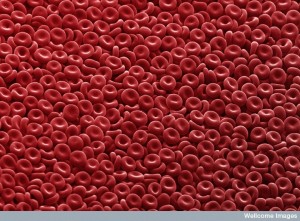2009.08.25 – urbaneangel – POLYCYTHEMIA VERA
http://urbaneangel.wordpress.com/2009/08/25/polycythemia-vera/
August 25, 2009, 12:56
Preamble
Polycythemia vera (PV) is a chronic myeloproliferative disorder caused by a mutation in the JAK2 gene. It represents one of a spectrum of blood cell proliferative disorders in which there is a clonal proliferation of a particular cell line. Other diseases in this spectrum include: essential thrombocytosis, myelofibrosis (from stromal cell proliferation) and chronic myelogenous leukemia.

Clinical
- occurs at any age
pruritis, especially after a warm bath
erythromelalgia (burning pain in feet or hands with erythema, pallor or cyanosis)
thrombosis (both arterial and venous)
non-specific GI symptoms
associated with gout
Diagnosis
“The PV Study Group” developed diagnostic criteria back in the 1960s:
MAJOR CRITERIA
Increased red cell mass
Arterial oxygen saturation > 92%
(Palpable) splenomegaly
MINOR CRITERIA
Platelet count > 400 000 /uL
Leukocyte count > 12 000 /uL
(Elevated serum B12 level, leukocyte alkaline phosphatase)
These criteria can now be complemented by blood tests:
erythropoeitin level (should be low in PV; high in secondary causes of erythocytosis)
genetic studies, including for the JAK2 mutation (essentially 100% have a JAK2 mutation)
Treatment
Phlebotomy to a target hematocrit is the primary therapy (<45% men, <42% women).
Low dose aspirin should be added unless there is a significant contraindication.
Hydroxyurea may be added if there is a high risk of thrombosis.
Other therapies, including interferon and radioactive phosphorus can be used, usually for intolerable pruritis.
Allopurinol may be added for gout management.
Prognosis
With treatment life expectancy is good, although there is an overall mortality almost twice that of age-matched peers. Main morbidity and mortality stems from thrombotic events and from progression to other hematologic malignancies including myelofibrosis, myelodysplastic syndrome and acute leukemia.
